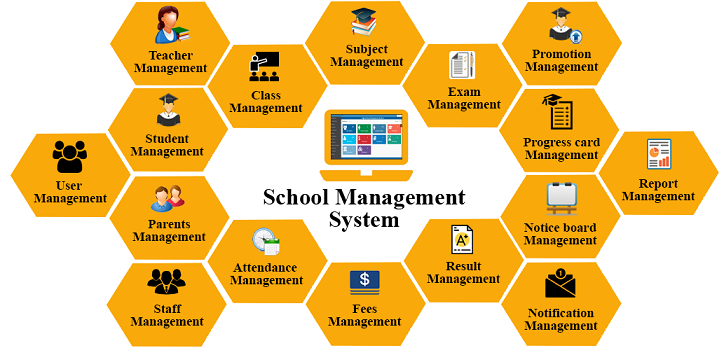Upgrade Your School with a Modern Management System
Introduction of School Management System
Schools are responsible for educating our future generations and preparing them for the challenges of the modern world. However, managing a school can be a complex and time-consuming task. From keeping track of student attendance to managing staff information and coordinating extracurricular activities, there are numerous tasks that need to be handled effectively for a school to run smoothly.
This is where School Management Systems come into play. A School Management System is a software application designed to automate and streamline the administrative and academic processes of a school. It provides a centralized platform for managing student and staff data, tracking attendance, managing fees, scheduling classes, and more. By using a School Management Software, schools can save time, increase efficiency, and improve communication between staff, students, and parents.
Benefits of a Modern School Management System
Increased Efficiency:
A modern School Management System automates many administrative tasks, such as attendance tracking, student registration, fee management, and more. This saves time and reduces errors, allowing staff to focus on more important tasks like teaching and student engagement.
Time Savings:
With a School Management Software, schools can save time on tasks such as creating and updating schedules, managing student records, and generating reports. This frees up time for teachers and administrators to focus on other important aspects of their work.
Enhanced Communication:
A School Management System provides a centralized platform for communication between teachers, staff, students, and parents. This allows for quick and efficient communication of important updates, announcements, and information.
Better Student and Staff Management:
By keeping track of student attendance, grades, and performance, a School Management System allows teachers to identify areas where students need additional support. Similarly, by managing staff information and performance, administrators can identify areas where professional development or additional support may be needed.
Improved Decision-Making:
With a School Management System, administrators have access to real-time data and analytics that can inform decision-making processes. This can help schools identify areas for improvement and make data-driven decisions that improve overall performance.
Key Features of a Modern School Management System
Student and Staff Information Management:
A School Management System should provide a centralized platform for managing student and staff information, including personal information, contact details, attendance records, and academic performance.
Attendance Management:
A School Management System should automate attendance tracking, allowing teachers to easily mark attendance and generate reports on student attendance patterns.
Fee Management:
A School Management System should allow for easy and secure fee collection, with features such as online payment options and fee receipt generation.
Examination Management:
A School Management System should help manage exams, including schedules, question paper generation, answer sheet evaluation, and result generation.
Timetable Management:
A School Management System should provide a platform for managing class schedules, teacher schedules, and exam schedules, allowing for easy and efficient scheduling and rescheduling.
Library Management:
A School Management System should provide a platform for managing library resources, including book catalogs, circulation, and inventory management.
Transportation Management:
A School Management System should provide a platform for managing school transportation, including routes, schedules, and vehicle maintenance.
Hostel Management:
A School Management System should provide a platform for managing hostel facilities, including room allocation, meal management, and hostel fee collection.
Factors to Consider When Choosing a School Management System
Scalability:
Consider the scalability of the School Management Software. As the school grows, the system should be able to accommodate additional students, staff, and resources.
Ease of Use:
The system should be easy to use, with an intuitive user interface that requires minimal training.
Customization:
Look for a School Management System that can be customized to meet the specific needs of the school. This may include custom fields, reports, and workflows.
Security:
The system should be secure, with features such as user authentication, role-based access control, and data encryption.
Integration:
Consider whether the School Management System can integrate with other software systems used by the school, such as accounting software or learning management systems.
Support and Training:
Look for a vendor that provides adequate support and training resources to ensure that the school can fully utilize the system’s features.
Cost:
Consider the cost of the system, including initial setup costs, ongoing maintenance costs, and any additional costs for customization or integration.
Reputation:
Consider the reputation of the vendor, including their track record of successful implementations, customer satisfaction, and longevity in the market.
Implementation of a School Management System
Needs Assessment:
Conduct a needs assessment to determine the specific requirements of the school, including the number of students and staff, the types of administrative and academic processes to be managed, and any specific features or functionality needed.
Vendor Selection:
Research School Management System vendors that meet the school’s needs, taking into account factors such as scalability, customization, security, integration, support, and cost.
System Configuration:
Work with the vendor to configure the School Management System to meet the school’s specific requirements. This may involve setting up custom fields, workflows, reports, and integrations with other software systems.
Data Migration:
Migrate existing data, such as student and staff information, attendance records, and academic performance data, into the School Management System. This may involve data cleaning and mapping to ensure that the data is accurate and consistent.
Training:
Provide training to school staff, teachers, and administrators on how to use the School Management System effectively. This may include training sessions, online tutorials, and user manuals.
Testing:
Test the School Management System to ensure that it is working as expected, with all features and functionality functioning properly.
Rollout:
Roll out the School Management System to the entire school community, including staff, teachers, students, and parents. This may involve providing access to the system via web portals or mobile apps, and providing ongoing support and assistance as needed.
Continuous Improvement:
Continuously monitor and evaluate the School Management System to identify areas for improvement and to ensure that the system is meeting the school’s needs over time.
Best Practices for Using a School Management System
- Establish clear goals and objectives for using the School Management System, such as improving communication between staff and parents, streamlining administrative processes, or enhancing student learning outcomes.
- Assign a system administrator or point person to oversee the School Management System and ensure that it is being used effectively and efficiently.
- Provide ongoing training and support to staff, teachers, and administrators to ensure that they are using the system effectively and taking advantage of all its features and functionality.
- Regularly review and update the School Management System’s configuration and settings to ensure that it is meeting the school’s changing needs and requirements.
- Encourage regular use of the School Management System by all members of the school community, including staff, teachers, students, and parents.
- Use the system to automate and streamline administrative tasks, such as attendance tracking, grade reporting, and scheduling, to reduce the workload on staff and improve efficiency.
- Leverage the system’s communication features, such as email and messaging, to keep staff, teachers, students, and parents informed about important events, announcements, and deadlines.
- Use the system to track and analyze student performance data, such as test scores and attendance records, to identify areas for improvement and inform instructional decision-making.
- Regularly monitor and evaluate the School Management System’s effectiveness, gather feedback from users, and make changes as needed to ensure that it is meeting the school’s goals and objectives.
Conclusion
In conclusion, a School Management System can greatly benefit schools by streamlining administrative and academic processes, improving communication and collaboration, and enhancing student learning outcomes. By selecting the right system, implementing it effectively, and using it following best practices, schools can achieve significant improvements in efficiency, effectiveness, and overall performance.
However, it is important to carefully consider the specific needs and requirements of the school and to provide ongoing training and support to ensure that the system is being used effectively and taking full advantage of its features and functionality. With the right approach, a School Management System can be a valuable tool for schools seeking to improve the quality of education and enhance the overall experience of students, staff, and parents alike.
What is a School Management System?
A School Management System is a software tool that helps schools manage various administrative and academic tasks, such as attendance tracking, grade reporting, scheduling, and communication.
How can a School Management System benefit my school?
A School Management System can streamline administrative processes, improve communication and collaboration, and enhance student learning outcomes.
What features should I look for in a School Management System?
Some important features to consider include attendance tracking, grade reporting, scheduling, communication tools, student information management, and academic performance analytics.
Is School Management System Easy to Use?
Yes, most School Management Systems are designed to be user-friendly and intuitive, with simple interfaces and easy navigation.
Can a School Management System help me save time and reduce my workload?
Yes, by automating administrative tasks and streamlining processes, a School Management System can help reduce the workload on staff and save time.
What types of schools can benefit from a School Management System?
Any type of school, from elementary schools to universities, can benefit from a School Management System.
Is a School Management System customizable?
Yes, most School Management Systems offer customizable features and settings to meet the specific needs and requirements of your school.
How can I choose the right School Management System for my school?
Consider factors such as your school’s size, budget, specific needs, and ease of use when selecting a School Management System.
Can a School Management System help improve student engagement and performance?
Yes, by providing real-time access to academic performance data and enabling better communication between teachers, students, and parents, a School Management System can help improve student engagement and performance.
Is it important to have a School Management System for my school's online presence?
Yes, having a School Management System can help improve your school’s online presence and visibility, which can be crucial for attracting new students and building trust with parents and stakeholders.
Contact us for More Services, Which we Provide
7) Chat Service
10) Web Hosting
12) Video Designing
Contact Us
+91-9380797662
info@emazel.com
Author


